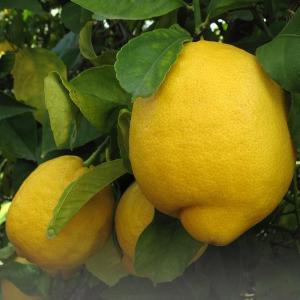
LEMON FRUIT (CITRUS LIMON) - PLANTS

BASE / GENERAL DATA
Information submited: June 9, 2015 Modified: May 15, 2018 By: OperaDreamhouse
A Lemon (Citrus Limon) is a small evergreen tree native to Asia.
The juice of the Lemon is about 5% to 6% citric acid, giving the fruit its distinctive, sour taste and making it a key ingredient in drinks and foods such as Lemonade and Lemon meringue pie.
The origin of the lemon is unknown, though lemons are thought to have first grown in Assam (a region in northeast India), northern Burma, and China.
Citrus Limon is the leading acid citrus fruit, because of its very appealing color, odor and flavor. The true lemon tree reaches 10 to 20 feet in height and usually has sharp thorns on the twigs. Leaves are reddish when young, and become dark green above, light green below.
Mildly fragrant flowers may be solitary, or there may be two or more. Buds are reddish. Opened flowers have 4 or 5 petals, white on upper surface, purplish beneath.
Fruit is oval with a nipple - like protuberance and is light - yellow. It is aromatic, and dotted with oil glands.
The first substantial cultivation of lemons in Europe began in Genoa in the middle of the 15th century. The Lemon was later introduced to the Americas in 1493 when Christopher Columbus brought Lemon seeds to Hispaniola on his voyages. Spanish conquest throughout the New World helped spread Lemon seeds.
Jews entered Europe near southern Italy no later than the first century AD, during the time of Ancient Rome. However, they were not widely cultivated. They were later introduced to Persia and then to Iraq and Egypt around 700 AD.
The Lemon was first recorded in literature in a 10th - century Arabic treatise on farming, and was also used as an ornamental plant in early Islamic gardens. It was distributed widely throughout the Arab world and the Mediterranean region between 1000 and 1150.
The juice of the Lemon is about 5% to 6% citric acid, giving the fruit its distinctive, sour taste and making it a key ingredient in drinks and foods such as Lemonade and Lemon meringue pie.
The origin of the lemon is unknown, though lemons are thought to have first grown in Assam (a region in northeast India), northern Burma, and China.
Citrus Limon is the leading acid citrus fruit, because of its very appealing color, odor and flavor. The true lemon tree reaches 10 to 20 feet in height and usually has sharp thorns on the twigs. Leaves are reddish when young, and become dark green above, light green below.
Mildly fragrant flowers may be solitary, or there may be two or more. Buds are reddish. Opened flowers have 4 or 5 petals, white on upper surface, purplish beneath.
Fruit is oval with a nipple - like protuberance and is light - yellow. It is aromatic, and dotted with oil glands.
The first substantial cultivation of lemons in Europe began in Genoa in the middle of the 15th century. The Lemon was later introduced to the Americas in 1493 when Christopher Columbus brought Lemon seeds to Hispaniola on his voyages. Spanish conquest throughout the New World helped spread Lemon seeds.
Jews entered Europe near southern Italy no later than the first century AD, during the time of Ancient Rome. However, they were not widely cultivated. They were later introduced to Persia and then to Iraq and Egypt around 700 AD.
The Lemon was first recorded in literature in a 10th - century Arabic treatise on farming, and was also used as an ornamental plant in early Islamic gardens. It was distributed widely throughout the Arab world and the Mediterranean region between 1000 and 1150.

SPIRITUAL PRACTISES DATA

MEDICINE / HEALTH DATA

BEAUTY / COSMETICS DATA

FOOD / COOKING DATA
COMMENTS
No comments.
Newest mixtures containing Lemon Fruit (Citrus Limon):

Home made wild dandelion honey
June 10, 2015


